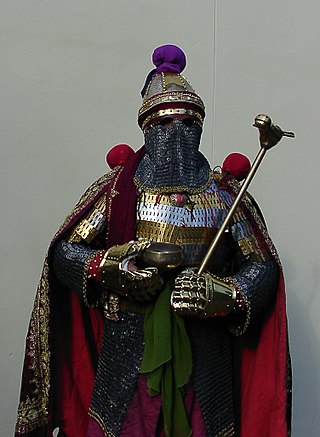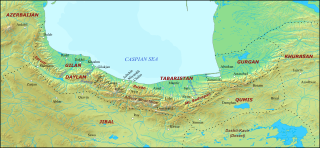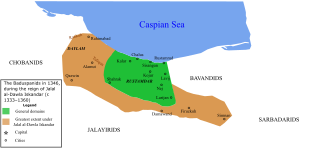
Jamasp was Sasanian King of Kings of Iran from 496 to 499. He was a son of Peroz I and younger brother of Kavad I. Jamasp was installed on the Sasanian throne upon the deposition of the latter by the nobility and clergy.

Mazyar was an Iranian prince from the Qarinvand dynasty, who was the ruler (ispahbadh) of the mountainous region of Tabaristan from 825/6 to 839. For his resistance to the Abbasid Caliphate, Mazyar is considered one of the national heroes of Iran by twentieth-century Iranian nationalist historiography. His name means "protected by the yazata of the moon".

Spāhbed is a Middle Persian title meaning "army chief" used chiefly in the Sasanian Empire. Originally there was a single spāhbed, called the Ērān-spāhbed, who functioned as the generalissimo of the Sasanian army. From the time of Khosrow I on, the office was split in four, with a spāhbed for each of the cardinal directions. After the Muslim conquest of Persia, the spāhbed of the East managed to retain his authority over the inaccessible mountainous region of Tabaristan on the southern shore of the Caspian Sea, where the title, often in its Islamic form ispahbadh, survived as a regnal title until the Mongol conquests of the 13th century. An equivalent title of Persian origin, ispahsālār or sipahsālār, gained great currency across the Muslim world in the 10th–15th centuries.
The Seven Great Houses of Iran, also known as the seven Parthian clans, were seven feudal aristocracies of Parthian origin, who were allied with the Sasanian court. The Parthian clans all claimed ancestry from Achaemenid Persians.

The Bavand dynasty, or simply the Bavandids, was an Iranian dynasty that ruled in parts of Tabaristan in what is now northern Iran from 651 until 1349, alternating between outright independence and submission as vassals to more powerful regional rulers. They ruled for 698 years, which is the second longest dynasty of Iran after the Baduspanids.

Tabaristan or Tabarestan, was the name applied to a mountainous region located on the Caspian coast of northern Iran. It corresponded to the present-day province of Mazandaran, which became the predominant name of the area from the 11th-century onwards.

Khurshid, erroneously designated Khurshid II by earlier scholars, was the last Dabuyid ispahbadh of Tabaristan. He succeeded to the throne at an early age, and was supervised by his uncle as regent until he reached the age of fourteen. Khurshid tried to assert his independence from his vassalage to the Caliphate, supported various rebellions and maintained diplomatic contacts with Tang China. Finally, the Abbasids conquered his country in 759–760, and captured most members of his family. Khurshid fled to Daylam, where he ended his life.

The Dabuyid dynasty, or Gaubarid dynasty, was a Zoroastrian Iranian dynasty that started in the first half of the 7th century as an independent group of rulers that ruled over Tabaristan and parts of western Khorasan. Dabuyid rule over Tabaristan and Khorasan lasted from around 642 to the Abbasid conquest in 760.

Farrukhan the Great was the independent ruler (ispahbadh) of Tabaristan in the early 8th century, until his death in 728. He is the first actually attested member of the Dabuyid dynasty, which is traditionally held to have ruled Tabaristan since the time of the Arab conquest of Iran. He successfully defended his realm against the Umayyad Arabs and Turks in the east and Daylamites in the west. He was also notable for being an active builder, constructing the city of Sari, where he moved his court.
Farrukhan the Little, also surnamed the Deaf (Korbali), was a member of the Dabuyid dynasty, which ruled Tabaristan as independent monarchs in the century after the Muslim conquest of Persia. The brother of the ispahbadh Dadhburzmihr, Farrukhan governed Tabaristan between 740/41 and 747/48 as regent for his underage nephew, Khurshid.
Gil Gavbara, also known as Gavbarih, was king and founder of the Dabuyid dynasty in 642, ruling until his death in 660.

The Paduspanids or Badusbanids, were a local Iranian dynasty of Tabaristan which ruled over Ruyan/Rustamdar. The dynasty was established in 665, and with 933 years of rule as the longest dynasty in Iran, it ended in 1598 when the Safavids invaded and conquered their domains.
Surkhab I was the second ruler of the Bavand dynasty from ca. 673 to 717.
Sharwin I was the fifth ruler of the Bavand dynasty from 772 to 817. He was the son and successor of Surkhab II.
Surkhab II was the fourth ruler of the Bavand dynasty from 755 to 772.
Vindadhhurmuzd, also known by the more correct form of Vandad Hormozd, was the ruler of the Qarinvand dynasty from 765 to 809.
Dabuya or Dabuyih, was the Dabuyid ruler (ispahbadh) of Tabaristan. He succeeded his father Gil Gavbara in 660 and reigned until his death in 712. His son, Farrukhan the Great succeeded him.
Wuzurgan, also known by its Modern Persian form of Bozorgan (بزرگان), was the name of the high nobility and the third class-rank of the four of the Sasanian aristocracy. After the fall of the Sasanian Empire, they reappear under the Dabuyid dynasty.

The Qarinvand dynasty, or simply the Karenids, was an Iranian dynasty that ruled in parts of Tabaristan (Mazandaran) in what is now northern Iran from the 550s until the 11th-century. They considered themselves as the inheritors of the Dabuyid dynasty, and were known by their titles of Gilgilan and Ispahbadh. They were descended from Sukhra, a Parthian nobleman from the House of Karen, who was the de facto ruler of the Sasanian Empire from 484 to 493. The Qarinvand dynasty is also considered to be the one of the last Zoroastrian dynasties before the rise of the Islamic Iranian dynasties

Ruyan, later known as Rustamdar (رستمدار), was the name of a mountainous district that encompassed the western part of Tabaristan/Mazandaran, a region on the Caspian coast of northern Iran.










